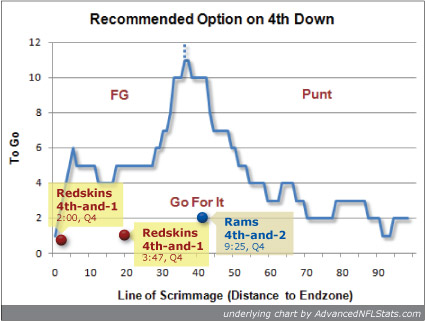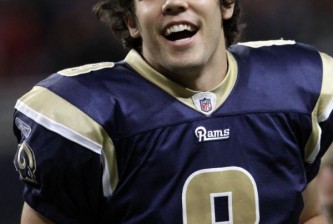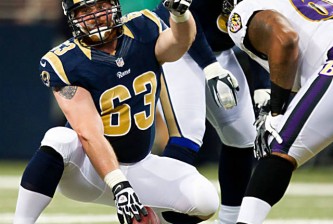Firstly, I have to tip my hat to Jeff at RamsGab, who took our in-game twitter conversation and went and found an empirical study from Advanced NFL Stats to back up the argument.
Yes, as the P-D recapped, Donnie Avery’s fumble inside the ten, with the Rams mounting their most impressive drive of the season (including preseason) killed their best chance to win. But not their last chance. Those last chances were dictated by three critical fourth down situations, that were handled by the two teams in two starkly different ways.

We look at each in depth, after the break:
STL: 4-2-WAS 41 (9:25) (Punt formation)
Their last good chance came after the Rams defense forced the Redskins into a 3-and-out, the first time that had happened since the game’s opening drive. They recovered from Donnie Avery’s critical cough-up, enraged rather than broken, and backed Jason Campbell and the Skins offense to the 1-inch line, and forced a short, returnable punt that set them up just inside the 50.
The Rams offense took over and went immediately back to the physical play that had them rolling down the field. The Redskins’ huge defensive line, so dominant in the first quarter, was noticeably worn down by the Rams’ 15-play grindfest, and had been off the field for only a minute forty on the game clock. Barely enough time to catch their breath, let alone to recover and recharge.
2nd-5: 3 yard run over right tackle.
3rd-2: incomplete pass to Laurent Robinson.
== Time Out, Rams ==
What happened next rests directly on the shoulders of our rookie coach, Steve Spagnuolo. And maybe, second-guessing this decision is what caused Spags to take an extra 15 minutes of “me time” before facing the media post-game.
The question is not just whether the decision to go for it was strategically justified (clearly, it was, whether you read the chart or read TMQ). The question is whether Spagnuolo has an accurate read on the shifting momentums of the game. Could he feel how fired up his Rams were, how dominant his offensive line had become against the gasping Redskins’ front four? Had he noticed that all but two St Louis rushes in the second half had gained three or more yards?
Moreover, did he not realize that his defense had completely sold out in its effort to produce that three-and-out? The ferocity, the pocket penetration in that three-play span was not the norm. It was not a new skill the Rams had suddenly mastered and could continue all game. It was a desperation series that demanded immediate payback from the Rams’ offense.
To that point, The Redskins offense’s average drive lasted nearly 10 plays. There may not have been many points on the board, but the Rams’ front seven were being physically dominated. Only strong tackling by the linebackers, and a quick, resilient secondary, kept this game from being a blowout to this point.
This is not just 20-20 hindsight – RamsHerd’s official position on the matter was stated definitively via Twitter, during the game.
Now, let’s consider the alternative. What if we went for it and lost? Firstly, we were already losing the game, so there’s no benefit in “playing not to lose.” Secondly, even if the Redskins walk down the field and score from the short porch of their own forty-something, the Rams would get the ball back with more time and better field position than where they ended up — on their own 4, with a minute-thirty left. And third, few would have blamed the coach for testing his team’s offensive mettle.
Brian Burke of Advanced NFL Stats offers three salient explanations of why NFL coaches fall into the mental trap of kicking so often in these situations:
- It used to be smart football … back when teams struggled to score more than once or twice per game.
- Coaches are more worried about job security than winning the game. If you punt and fail, fans blame the defense. If you go for it and fail, fans blame you.
- Coaches fear losing more than they enjoy winning
But in this situation, coach Spagnuolo got the local calculus wrong. St Louis fans will automatically blame the offense if the team fails. Judging from talk radio and the internets, we hate Marc Bulger, and we only grudgingly like Steven Jackson. And St Louis has no fear of losing — we abhor it. We walk away from it in droves. Winning is the only thing that has ever brought fans to the Dome. To put it all on the line at this point, in hopes of a win, would have earned major points with the St Louis fans.
Conversely, after our fateful punt, Jim Zorn and the Redskins faced two fourth-down decisions, and went the opposite way on both with a much different outcome.
WAS: 4-1-STL 20 (3:47) Portis left tackle to STL 11 for 9 yds
Judging just from field position, the Redskins had a very make-able field goal attempt here. But they would have left a lot of time on the clock, and would have only a five-point lead. Any fluke play, any burst through the line or receiver behind the secondary means game-over. Moreover, their offense had found their rhythm again through running the ball against the now-demoralized Rams defensive front.
Zorn challenged his team to keep charging, to play for the win, and they responded with a first down.
WAS: 4-1-STL 2 (2:00) Portis left end to STL 4 for -2 yds
Now, this was a much more hotly debatable call. As you can see from the chart above, this is a coin-flip decision. And as Thomas Boswell of the Washington Post points out in a very good critique, the Rams needed only a field goal to win — a much easier drive in theory than a touchdown drive. And that may be true against the high-powered vertical offenses of the NFC East, but not against St Louis.
At the time I agreed fully with Zorn’s call to go for it, and in hindsight can find no fault with it.
Firstly, he continued to challenge his team toward the end zone, toward the killshot. He is trying to cultivate an attitude that his team will need to compete. Secondly, a lot more bad things can happen off a kickoff return to a desperate team, than can happen if you pin them down inside their own five. Thirdly, his defense just had a 15-play reprieve on the bench to get fully recharged for a make-or-break series.
Bottom line, when the game is on the line, the coach should feel lucky if their best unit is on the field. By the time of their 4th-and-2, the Rams’ best unit had become their run-blocking offensive line, but Spagnuolo pulled them off the field. By the time of the Redskins’ 4th-and-1 at the two-minute warning, their pass rush was their best unit, and Zorn trusted them to go apeshit on Marc Bulger. Zorn’s gamble paid off, and Spagnuolo’s “safe” play did not. And that was the difference in a very close game.






















